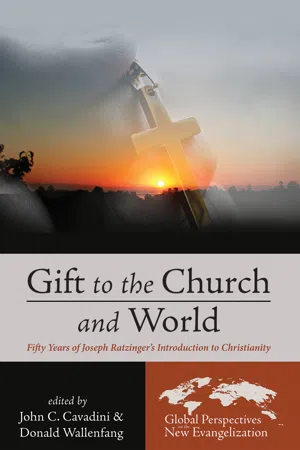![]()
IV. Dogmatic Theology
![]()
10
Joseph Ratzinger’s “Spiritual Christology”
Rev. Robert P. Imbelli
Introduction
This article offers some considerations on the topic: “Joseph Ratzinger’s Spiritual Christology.” It does so mindful of the frequently alleged disconnect between doctrine and experience, manifest in such slogans as “I’m spiritual, but not religious.” This slogan has its ecclesiastical counterpart in the increasingly prevalent disjunction between what is “doctrinal” and what is “pastoral.” But I also address the topic in light of an ever-growing tendency towards academic specialization that often deems “spirituality” not ingredient to the theological curriculum, but “extra-curricular,” reserved to the chapel and not the classroom.
I will attempt to show, therefore, how theology and spirituality are intimately and exemplarily related in Ratzinger’s thought—just as they were for his theological ancestors and mentors: Augustine and Bonaventure, Guardini and de Lubac. For him, as for them, “Mystery” and “mysticism” (faith’s objective content and its subjective appropriation) are inseparable, and both have a distinctive “Christic form.” Ratzinger will come to call this persuasion and approach a “spiritual Christology.”
The article will proceed in five parts: (I) Looking Back . . . and Forward to Vatican II; (II) Ratzinger on Revelation: the Inextricable Nexus of Theology and Spirituality; (III) Introduction to Christianity: Laying the Foundations of a “Spiritual Christology”; (IV) Further Delineating “Spiritual Christology”; and (V) Towards a Eucharistic Mysticism and Spirituality.
But let me first dwell briefly upon the two images that accompany this reflection: the risen/ascended Christ bestowing the Holy Spirit upon the apostles (from the great entrance door of the twelfth century Basilica of Saint Mary Magdalene in Vézelay, France) and the painting of the Transfiguration (by the late thirteenth century Sienese painter, Duccio di Buoninsegna).
Panel Image from the 12th-century Basilica of Saint Mary Magdalene in Vézelay, France.
“Transfiguration” by the late 13th-century Sienese painter Duccio of Buoninsegna.
We know the crucial importance of images and of the aesthetic dimension of existence for Joseph Ratzinger/Pope Benedict. In his well-known 2002 address in Rimini, Ratzinger said: “Looking at icons, and in general at the great masterpieces of Christian art, leads us on an interior way, a way of transcendence, and thus brings us, in this purification of sight that is a purification of the heart, face to face with beauty, or at least with a ray of it.” A few years later, explaining why he insisted that images of Christian art be included in the Compendium to the Catechism of the Catholic Church, then Cardinal Ratzinger wrote: “In a culture of images, a sacred image can express much more than what can be said in words, and be an extremely effective and dynamic way of communicating the Gospel message.”
In this spirit and with this same conviction, I offer these two images to recapitulate aesthetically and affectively all that I write here. They depict imaginatively and strikingly the absolute novum of the risen, ascending Jesus Christ and the transformative way of life to which he calls his disciples. Hopefully, these images will guide our meditations both “ante et post scriptum”! They certainly have continued to inspire my prayer and reflection since I first encountered them during a Junior Year Abroad sixty years ago.
I. Looking Back . . . and Forward to Vatican II
I begin by “Looking back and forward to Vatican II.” But, in doing so, I would like to begin with a note of personal witness.
By the providence of God and the generosity of the Archbishop and people of the Archdiocese of New York, I began my theological studies in Rome in the Fall of 1962—the time of the opening of the Second Vatican Council. Vatican II, of course, remains the indispensable point of reference for Catholic theology and spirituality even after more than fifty years. Indeed, one might legitimately wonder: have we yet received it fully, perhaps even “misremembered” it?
I certainly had some excellent professors at the Gregorian University during the years of the Council—Bernard Lonergan, René Latourelle, Francis Sullivan (to name a few). But, to be honest, most of the real excitement took place in the evenings at lectures by Rahner and Congar, Chenu and Cullman. For a time Rome seemed once again the center of the world. And to experience the gradual opening of a formerly rather closed clerical Rome during that period was marvelous to behold.
November 20, 1962 was a particularly remarkable day. In my memory, I still vividly recall the astonishment we all experienced. On that day, the document “On the Sources of Revelation,” prepared by the Theological Commission (headed by Cardinal Ottaviani) was voted on by the Council fathers. There had been considerable discussion of the document in the days preceding the vote, and it had received much criticism for its style—overly scholastic and abstract, insufficiently biblical, historical, and ecumenical—a product of the reigning neo-scholasticism of the time.
When it came time to vote, more than 60 percent of the bishops chose not to accept the draft. But, according to the ground rules of the Council, it required a two-thirds negative vote to remand the document to Committee.
At that point, Pope John XXIII, with blessed common sense, intervened. He ordered that the document be re-composed...


